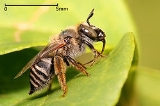
Apinae
Encyclopedia
The Apinae is the subfamily that includes the majority of bee
s in the family Apidae
, including the familiar "corbiculate
" bees (honey bee
s, stingless bee
s, orchid bees
, and bumblebee
s), plus all but two of the groups (Nomadinae
and Xylocopinae
) that were previously classified in the family Anthophoridae. Most species (other than honey bees, bumblebees, and stingless bees) are solitary, though several of the tribes
are entirely cleptoparasitic, such as the Ericrocidini, Isepeolini, Melectini
, Osirini
, Protepeolini, and Rhathymini.
Certain behaviors are known from members of the Apinae that are rarely seen in other bees, including the habit of males forming "sleeping aggregations" on vegetation; several males gathering on a single plant in the evening, grasping a plant with their jaws and resting there through the night (sometimes held in place only by the jaws, with the legs dangling free in space). Also known from Apinae is the habit of gathering floral oils instead of pollen
for use as a larval food; this behavior is otherwise known only from a few lineages in the family Melittidae
.
Bee
Bees are flying insects closely related to wasps and ants, and are known for their role in pollination and for producing honey and beeswax. Bees are a monophyletic lineage within the superfamily Apoidea, presently classified by the unranked taxon name Anthophila...
s in the family Apidae
Apidae
The Apidae are a large family of bees, comprising the common honey bees, stingless bees , carpenter bees, orchid bees, cuckoo bees, bumblebees, and various other less well-known groups...
, including the familiar "corbiculate
Pollen basket
The pollen basket or corbicula is part of the tibia on the hind legs of the four related lineages of apid bees that used to comprise the family Apidae: the honey bees, bumblebees, stingless bees, and orchid bees...
" bees (honey bee
Honey bee
Honey bees are a subset of bees in the genus Apis, primarily distinguished by the production and storage of honey and the construction of perennial, colonial nests out of wax. Honey bees are the only extant members of the tribe Apini, all in the genus Apis...
s, stingless bee
Stingless bee
Stingless bees, sometimes called stingless honey bees or simply meliponines, are a large group of bees, comprising the tribe Meliponini . They belong in the family Apidae, and are closely related to common honey bees, carpenter bees, orchid bees and bumblebees...
s, orchid bees
Euglossini
Euglossine bees, also called orchid bees, are the only group of corbiculate bees whose non-parasitic members do not all possess eusocial behavior. Most of the species are solitary, though a few are communal, or exhibit simple forms of eusociality...
, and bumblebee
Bumblebee
A bumble bee is any member of the bee genus Bombus, in the family Apidae. There are over 250 known species, existing primarily in the Northern Hemisphere although they are common in New Zealand and in the Australian state of Tasmania.Bumble bees are social insects that are characterised by black...
s), plus all but two of the groups (Nomadinae
Nomadinae
The subfamily Nomadinae is the largest and most diverse group of cleptoparasitic "cuckoo bees" with 31 genera in 10 tribes; they occur worldwide, and utilize many different types of bees as hosts. As parasites, they lack a pollen-carrying scopa, and are often extraordinarily wasp-like in appearance...
and Xylocopinae
Xylocopinae
The subfamily Xylocopinae occurs worldwide, and includes the familiar Carpenter bees and their more obscure relatives; there are many species, but relatively few genera...
) that were previously classified in the family Anthophoridae. Most species (other than honey bees, bumblebees, and stingless bees) are solitary, though several of the tribes
Tribe (biology)
In biology, a tribe is a taxonomic rank between family and genus. It is sometimes subdivided into subtribes.Some examples include the tribes: Canini, Acalypheae, Hominini, Bombini, and Antidesmeae.-See also:* Biological classification* Rank...
are entirely cleptoparasitic, such as the Ericrocidini, Isepeolini, Melectini
Melectini
The Melectini are a tribe of medium- to large-sized apid bees found essentially worldwide. They are brood parasites of the related typical digger bees and will occasionally visit flowers e.g...
, Osirini
Osirini
The Osirini are a tribe of cleptoparasitic apid bees, all but one genus exclusively from the Neotropics, and laying their eggs in the nests of bees in the apid tribe Tapinotaspidini; the one exceptional genus is Epeoloides, which has one North American species and one European species, both of...
, Protepeolini, and Rhathymini.
Certain behaviors are known from members of the Apinae that are rarely seen in other bees, including the habit of males forming "sleeping aggregations" on vegetation; several males gathering on a single plant in the evening, grasping a plant with their jaws and resting there through the night (sometimes held in place only by the jaws, with the legs dangling free in space). Also known from Apinae is the habit of gathering floral oils instead of pollen
Pollen
Pollen is a fine to coarse powder containing the microgametophytes of seed plants, which produce the male gametes . Pollen grains have a hard coat that protects the sperm cells during the process of their movement from the stamens to the pistil of flowering plants or from the male cone to the...
for use as a larval food; this behavior is otherwise known only from a few lineages in the family Melittidae
Melittidae
The family Melittidae is a small bee family, with some 60 species in 4 genera, restricted to Africa and the northern temperate zone. Historically, the family has included the Dasypodaidae and Meganomiidae as subfamilies, but recent molecular studies indicate that Melittidae was paraphyletic, so...
.

